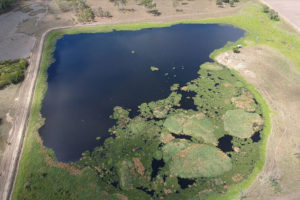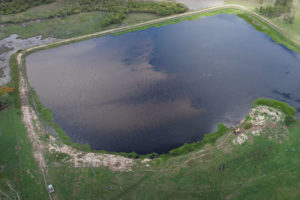Reef Catchments is working to protect and restore wetlands south of Mackay, assisting
landholders in the Sandringham Wetland Complex to manage their land and improve grazing
practices.
As part of this project, which is funded by the Australian Government’s Reef Trust, a
long reach excavator has been brought in for a trial to mechanically remove water hyacinth
and put it into the adjacent fallow cane paddocks as mulch, as an alternative to spraying vast
amounts of herbicides to control this localised infestation.
Reef Catchments and the landholder are investigating if the mulch layer of aquatic weeds in
the paddock will improve soil conditions and benefit the next cane crop, optimising the balance
between production and ecosystem protection, promoting a health environment for the native
birds and fish species, and reducing pollutants running off to the Great Barrier Reef lagoon. The
potential for biocontrol releases is also being investigated, which could deal with the infestation
long-term, since the seed bank can be viable for up to 25 years.
The Plane Creek catchment, in which the Sandringham Wetland Complex is located, covers
2,539 square kilometres, and 28% of the Mackay Whitsunday Isaac (MWI) region. Reef
Catchments is partnering with landholders in the Sandringham Wetland Complex to improve fish
habitat, restore native vegetation and improve water quality.
Assisting landholders
Reef Catchments has already assisted local landholders to implement over 6.5km of new wildlife
friendly fencing and 11 additional off-stream watering points to manage stock access in sensitive
ecological areas. Wetland habitats are an important part of many grazing properties in
Queensland. Most wetlands in Queensland are on private land, and many are on properties that
run grazing businesses.
Reef Catchments Project Officer – Conservation and Communities, Carlos Bueno, said, “The
Sandringham Wetland Complex provides many vital functions to the local coastal area due to its
unique soil types and water holding capacity.
“Improvements and adoption of best management
practices on these critical ecosystems can enhance the ecosystem and improve grazing
productivity.
“Graziers value the Sandringham Wetland Complex for providing water and feed for stock, and
reserves during the dry season or droughts. The impacts of grazing on wetlands can include
reduced water quality from additional nutrient inputs, increased soil compaction and reduced
native vegetation.”
Wetlands are the boundary between two different ecosystems, dry and wet, which means they
have a unique role in nutrient exchange and water supply to surrounding lands. They also provide
habitat, food, and shelter to many different plants and animals including endangered, vulnerable,
and migratory species.

